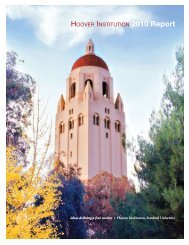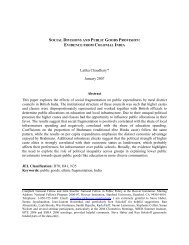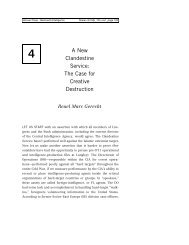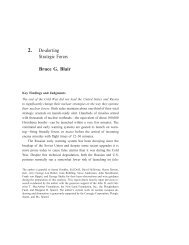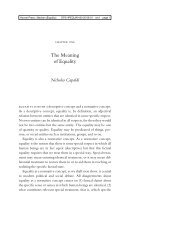Civil Liberties and Security in Cyberspace - Hoover Institution
Civil Liberties and Security in Cyberspace - Hoover Institution
Civil Liberties and Security in Cyberspace - Hoover Institution
You also want an ePaper? Increase the reach of your titles
YUMPU automatically turns print PDFs into web optimized ePapers that Google loves.
<strong>Hoover</strong> Press : Cyber DP5 HPCYBE0500 06-11-:1 11:53:04 rev1 page 186<br />
186 Ekater<strong>in</strong>a A. Drozdova<br />
tective one <strong>and</strong> a reactive one. 2 Each is constra<strong>in</strong>ed <strong>in</strong> different ways.<br />
The protective approach aims to deter crim<strong>in</strong>als through measures<br />
that deny access or make a potential target less vulnerable to an attack.<br />
This approach is focused on defense. It <strong>in</strong>volves design<strong>in</strong>g more secure<br />
Internet protocols, <strong>in</strong>troduc<strong>in</strong>g trusted routers <strong>and</strong> virtual private networks,<br />
<strong>and</strong> utiliz<strong>in</strong>g firewalls, encryption, automated <strong>in</strong>trusion-detection<br />
systems, <strong>and</strong> other security measures. The reactive approach seeks<br />
to deter the threat through effective <strong>in</strong>vestigation, prosecution, <strong>and</strong><br />
punishment. 3 Both approaches <strong>in</strong>volve monitor<strong>in</strong>g <strong>and</strong> diagnos<strong>in</strong>g<br />
abnormal <strong>and</strong> unauthorized activity. The protective approach favors<br />
automation as well as oversight <strong>and</strong> decisionmak<strong>in</strong>g by computer<br />
security experts. The reactive one depends more heavily on the participation<br />
of law enforcement <strong>and</strong> requires end user–oriented (rather than<br />
anonymous) traffic analysis, which may be as <strong>in</strong>trusive as scann<strong>in</strong>g of<br />
attached files, keyword searches, <strong>and</strong> content filter<strong>in</strong>g for signs of<br />
potential breaches of crim<strong>in</strong>al law. Real-time <strong>in</strong>vestigative capabilities<br />
may extend to creat<strong>in</strong>g embedded data collection <strong>in</strong>frastructures <strong>and</strong><br />
modify<strong>in</strong>g hardware <strong>and</strong>/or software to provide for confidential law<br />
enforcement access to bus<strong>in</strong>ess, governmental, <strong>and</strong> private computer<br />
networks. 4<br />
The two approaches can be complementary. Their relative weights<br />
depend on the preferences <strong>and</strong> capabilities of implement<strong>in</strong>g parties.<br />
Although there are significant obstacles to achiev<strong>in</strong>g high levels of<br />
cyber security, 5 the protective approach is likely to facilitate greater<br />
2. As discussed at the Conference on International Cooperation to Combat Cyber<br />
Crime <strong>and</strong> Terrorism, <strong>Hoover</strong> <strong>Institution</strong>, Stanford University, December 6–7, 1999.<br />
Neither exhaustive nor mutually exclusive, the two approaches provide a useful framework<br />
for evaluat<strong>in</strong>g with respect to civil liberties the technical <strong>and</strong> legal measures<br />
aga<strong>in</strong>st cyber crime.<br />
3. Whitfield Diffie, presentation at the Stanford Conference, December 6–7,<br />
1999.<br />
4. Forms of this are be<strong>in</strong>g implemented by the Russian <strong>and</strong> U.S. governments, as<br />
discussed <strong>in</strong> the privacy section below.<br />
5. These obstacles <strong>in</strong>clude budget constra<strong>in</strong>ts, technical complexity, unclear responsibilities,<br />
security weaknesses <strong>in</strong> products, lack of awareness, lack of good security<br />
tools, lack of competent <strong>in</strong>formation security personnel, privacy <strong>and</strong> ethics issues, <strong>and</strong>





